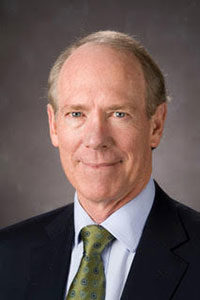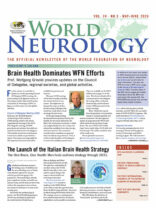
William Carroll, MD
 This is the most important event in the last century. Arguably, aside from the tragic loss of life, the widespread and virtually simultaneous shutdown of global and regional economies, and the restriction of individual movements and travel with the enforcement of social distancing has no precedent. Wars, nuclear bombs, AIDS, global financial crises, and the threat of global warming have not done so much, so rapidly, to so many. Countries, governments, peoples, and individuals are all learning, some the hard way, that without methods to prevent the mutation of new zoonotic viruses and vaccines to combat them, public health measures are all we have to reduce the toll of human lives and the economic consequences which, in turn, also impact human life and livelihoods. The constraints effected by the implementation of public health restrictions and the unparalleled rise in the use and need for health, hospital, and ICU resources affects all aspects of health care globally and at all levels of socioeconomic standing.
This is the most important event in the last century. Arguably, aside from the tragic loss of life, the widespread and virtually simultaneous shutdown of global and regional economies, and the restriction of individual movements and travel with the enforcement of social distancing has no precedent. Wars, nuclear bombs, AIDS, global financial crises, and the threat of global warming have not done so much, so rapidly, to so many. Countries, governments, peoples, and individuals are all learning, some the hard way, that without methods to prevent the mutation of new zoonotic viruses and vaccines to combat them, public health measures are all we have to reduce the toll of human lives and the economic consequences which, in turn, also impact human life and livelihoods. The constraints effected by the implementation of public health restrictions and the unparalleled rise in the use and need for health, hospital, and ICU resources affects all aspects of health care globally and at all levels of socioeconomic standing.
In doing so, it increases the risk, both directly and indirectly, to those vulnerable and those not so vulnerable with varying levels of disability at all ages and to those who are in need of care, particularly neurological care. The dislocation of livelihoods and risk to health is greatest for the vulnerable. This also includes those who are in foreign countries for a variety of economic reasons, but usually to support themselves or their families in their home country as well as those seeking refuge from conflict and strife. I believe the WFN has a role to play at this time. As bad as the rapidity of infection and rise in the death toll have been to date, even worse is to contemplate the ravaging effects upon countries without the resources of Europe, North America, and the advanced nations of Asia. Africa, India, parts of central and east Asia, South America, and a host of smaller less-resourced countries around the world are at risk over the coming year or more.
The WFN Has an Important Role in This Pandemic.
First, we need to support the WHO. Despite being criticized for being slow to call COVID-19 a pandemic and for bias in its assessment of the situation in the Wuhan province of China early on, it is the only global public health organization. In its daily updates during the executive board meeting of the WHO in Geneva in February, which I attended, it was active, alert to the need for resources in Africa and in Iran, and successful in its procurement and deployment. It cannot mandate actions nor enter countries without permission. The WHO continues to operate amid a growing distrust of globalized intervention and previous criticism. Nevertheless, the advice from Geneva and the regional WHO bodies has been consistent and remains appropriate. Countries must institute and relax measures as they see fit for their particular circumstances.
Second, it is important to support national and regional endeavors through each of our national health services to both meet the impact of COVID-19 on health and life, control the rate of spread of the virus, and ensure patients with neurological disorders are not overlooked as well as endeavors to mitigate the economic burden of the pandemic. This is no easy task. Although principles to guide countries and populations are emerging, they will undoubtedly require local and national interpretation to fit the circumstances. It is clear that different countries will have different tolls at different times and some, if not all, will experience similar differences with successive waves of the infection.
Third, the WFN and its members have a dual role neurologically over and above assisting health services to meet the pandemic. First, as I have already mentioned, the importance of maintaining the high standard of neurological care for those with neurological illnesses and the mitigation wherever possible of the effects of the pandemic on them, whether it be on support services, infusion centers, clinics, or diagnostic services. It is also important to be alert to the possibility of neurological injury caused by COVID-19 and to papers and publications claiming the same prematurely and creating unnecessary alarm. In this time of fear and heightened sensitivity, it behoves us all to analyze carefully reports purporting to identify neurological injury as part of the pandemic. While the SARS-CoV-2 virus has not been proven to be neurotropic, there have been several letters and reports, some in reputable journals, of small series of SARS-CoV-2 patients with severe infections having neurological signs and deficits. To my knowledge, many of these reports to date have not involved trained neurologists nor have they adequately assessed the effects of comorbidities or been followed up. Furthermore, there have been none claiming neurological disease from those with milder infections. At this time, there have been at least two reports totaling a handful of cases with Guillain Barre Syndrome in association with COVID-19 infection (including one who tested negative for COVID-19 after the onset of neuropathy) and two of acute necrotizing encephalopathy, neither of which could be described as a significant risk for COVID-19 patients. It is up to us to see clearly in this “fog of war.”
The WFN has adopted the policy on its website to post material only from peer-reviewed journals and if it has not been peer-reviewed optimally to warn readers to assess the material even more carefully. The WFN is alert to the need for all neurologists to be vigilant and to look for evidence of neurological injury during this pandemic. All of us are aware of the Von Economo-Cruchet disease of encephalitis lethargica described in 1917 and merging then among the 1918-1919 “Spanish flu” pandemic. The WFN has supported its Environmental Neurology Specialty Group chaired by Prof. Gustavo Roman to establish a registry of WFN member societies who are collecting country-wide or center-based data and is aware of moves to establish a “COVID-19 Neuro Research Coalition.” On a more individual note, the WFN now has a bulletin board on its COVID-19 page for member societies to post brief reports (c-19@wfneurology.org) on the situation in general or on specific aspects in their country or region to apprise the federation and the membership. It goes without saying that such sharing has a number of advantages, not the least in maintaining the feeling of community while we are all separated.
Effects of COVID-19 on the WFN
Briefly, I should address the WFN timetable in this new world. First, you will have seen the cancellation of many important meetings already and the possibly optimistic postponement of others. The Annual General meeting of the WFN Council of Delegates remains scheduled for 9 a.m. to Noon, Sept. 9,
during the ECTRIMS/ACTRIMS meeting in Washington. But it may well be changed to a virtual meeting. The WFN was already moving to enhance its electronic activities for a number of reasons before the pandemic so it will have two new video productions available shortly on its website. The first is about the WFN now and the second about the 2021 World Congress of Neurology in Rome. The World Brain Day program on Parkinson’s disease and shared with the International Parkinson Disease and Movement Disorders Society is proceeding well, and a new initiative on brain health will run in parallel. I will have more to say on both in my next column.
Finally, on behalf of the Trustees and staff of the WFN, I wish you and your members and their families all safe passage through this crisis. •
WFN President
